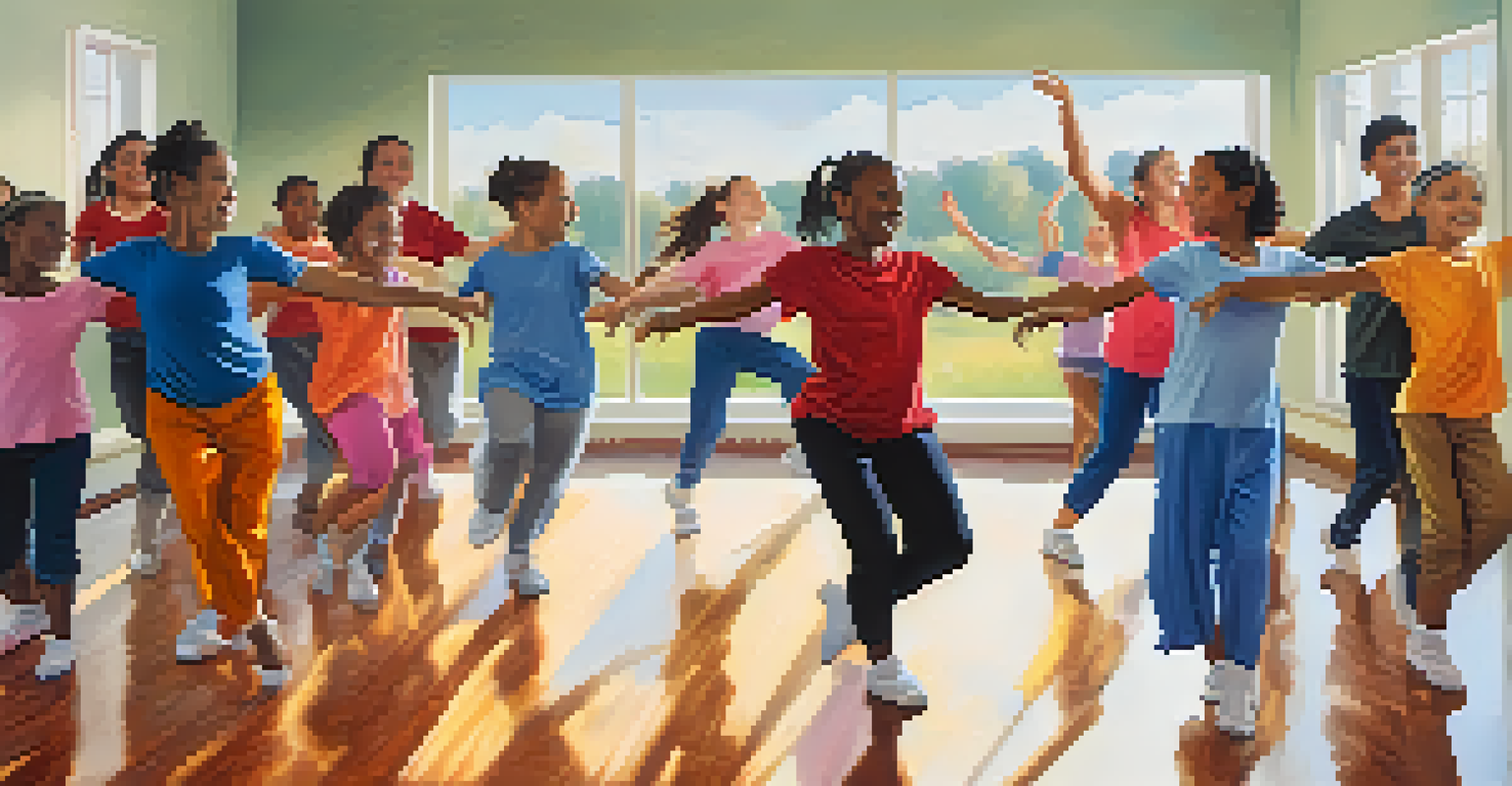Using Dance to Cultivate Resilience and Adaptability

The Connection Between Dance and Emotional Resilience
Dance is often seen as a joyful expression, but it also serves as a powerful tool for emotional resilience. When we dance, we tap into our feelings, allowing us to process emotions in a unique way. This connection helps us to bounce back from life's challenges, transforming pain into creativity.
Dance is the hidden language of the soul.
For instance, think of a dancer performing a piece that tells a story of overcoming obstacles. Each movement reflects the struggles and triumphs, resonating with anyone who's faced difficulties. This not only builds emotional strength but also creates a sense of community among those who share similar experiences.
Moreover, engaging in dance allows individuals to release pent-up emotions, fostering a sense of relief and adaptability. As we learn to express ourselves through movement, we develop a deeper understanding of our feelings, making it easier to cope with life’s ups and downs.
How Dance Challenges Us to Adapt
Adapting to new dance styles or choreography is an excellent metaphor for life’s unpredictability. Each dance form, whether ballet, hip-hop, or salsa, presents unique challenges that require flexibility and creativity to master. This process mirrors how we face unexpected changes in our daily lives.

For example, learning a new routine often means stepping out of our comfort zones. As we navigate through unfamiliar steps, we learn to embrace uncertainty. This practice of adapting in a fun and engaging environment cultivates a mindset that is better equipped to handle real-world challenges.
Dance Enhances Emotional Resilience
Engaging in dance helps individuals process emotions, fostering a sense of community and building emotional strength.
Ultimately, the ability to adapt in dance translates into resilience in life. As we become more comfortable with change on the dance floor, we find it easier to adjust to shifts in our personal and professional lives, reinforcing our capacity to thrive amidst adversity.
Dance as a Form of Stress Relief
Dance is not just a physical activity; it also serves as a powerful stress reliever. When we immerse ourselves in movement, our bodies release endorphins—those feel-good hormones that naturally elevate our mood. This biochemical response helps us cope with stress and promotes a sense of well-being.
The only way to make sense out of change is to plunge into it, move with it, and join the dance.
Imagine coming home after a long day and putting on your favorite music to dance. As the rhythm takes over, worries fade, and your body feels lighter. This simple act of dancing can turn a stressful day into a moment of joy, illustrating how movement provides relief and fosters resilience.
Furthermore, the communal aspect of dance, whether in a class or a social gathering, creates support networks. Being part of a dance community can enhance feelings of belonging, making it easier to face life’s challenges together. This shared experience reinforces adaptability, as we learn from one another in a safe space.
Building Confidence Through Dance
Dance is a fantastic way to build confidence, which is crucial for resilience. As we learn new moves and improve our skills, we gain a sense of accomplishment that translates into other areas of life. This boost in self-esteem helps us tackle challenges with a more positive outlook.
Consider a dancer preparing for a performance. Each rehearsal helps them grow not just as a performer but as an individual. The confidence gained from mastering a routine can empower them to face personal challenges, reinforcing the idea that they can overcome obstacles.
Adaptability Through Dance Practice
Learning new dance styles teaches flexibility and creativity, equipping us to handle life's unpredictability.
By stepping onto the dance floor, we also learn to embrace vulnerability. Sharing our passion with others encourages us to take risks and be authentic, further solidifying our resilience. This newfound confidence becomes a powerful tool in navigating life's uncertainties.
The Role of Creativity in Resilience and Adaptability
Creativity plays a significant role in both dance and resilience. When we dance, we often improvise, allowing ourselves to explore new movements and express emotions freely. This creativity not only enriches our dance experience but also enhances our ability to think outside the box in challenging situations.
For instance, improvisational dance encourages us to let go of preconceived notions and embrace spontaneity. This practice can help us develop a more adaptable mindset, making it easier to pivot when life throws unexpected curveballs our way. The ability to innovate in dance can directly translate to problem-solving in daily life.
Moreover, engaging in creative expression through dance fosters a sense of joy and fulfillment. This joy can serve as a buffer against stress, bolstering our resilience. As we cultivate creativity on the dance floor, we also nurture the skills needed to adapt and thrive in an ever-changing world.
The Community Aspect of Dance and Support Systems
Dance often brings people together, creating a sense of community that is crucial for resilience. Whether it's a dance class, a performance, or a social event, these gatherings foster connections that provide support during tough times. Being part of a community can significantly enhance our ability to adapt to life's challenges.
For example, consider a group of dancers preparing for a show. They rely on one another for feedback, encouragement, and motivation. This collaboration strengthens their bond and empowers each individual to face personal struggles, knowing they have a support system behind them.
Community Support in Dance
Being part of a dance community provides essential support, enhancing resilience through shared experiences and encouragement.
Moreover, sharing experiences within a dance community can inspire resilience. As members witness each other's journeys, they learn valuable lessons about persistence and adaptability. This shared understanding nurtures an environment where everyone feels equipped to tackle obstacles together.
Incorporating Dance into Daily Life for Resilience
Integrating dance into daily routines can significantly enhance resilience and adaptability. Whether it's a quick solo dance session in your living room or joining a weekly class, making time for movement can have profound benefits. It doesn’t require a performance; the act of dancing itself is a form of self-care.
Think about how starting your day with a dance can set a positive tone. It energizes you and encourages a mindset ready to tackle the day’s challenges. This daily practice builds a habit of resilience, as you learn to embrace each day with creativity and joy.

Ultimately, finding ways to incorporate dance into your life enriches your emotional toolkit. By making movement a priority, you cultivate a resilient spirit that can adapt to whatever life throws your way. Dance becomes not just an activity, but a lifestyle that empowers you to thrive.